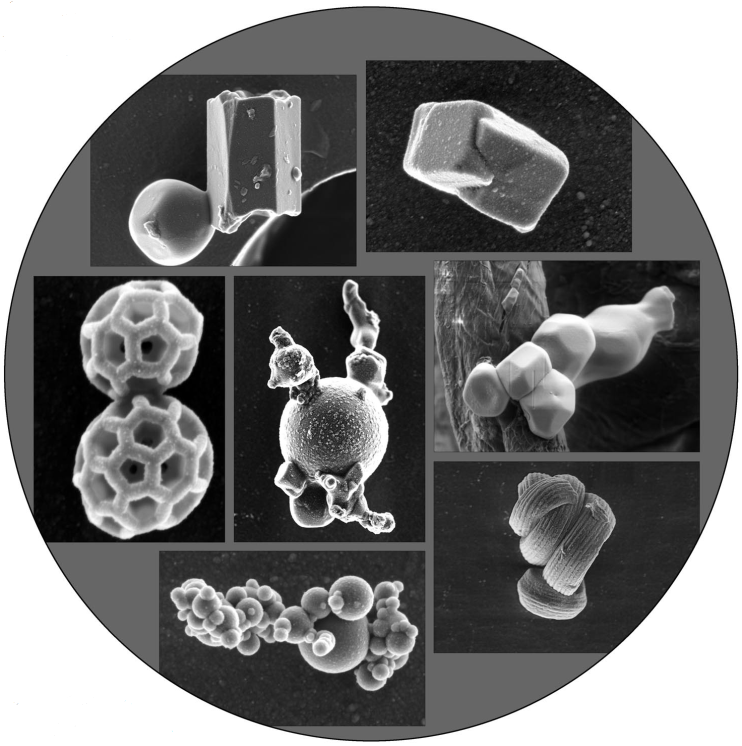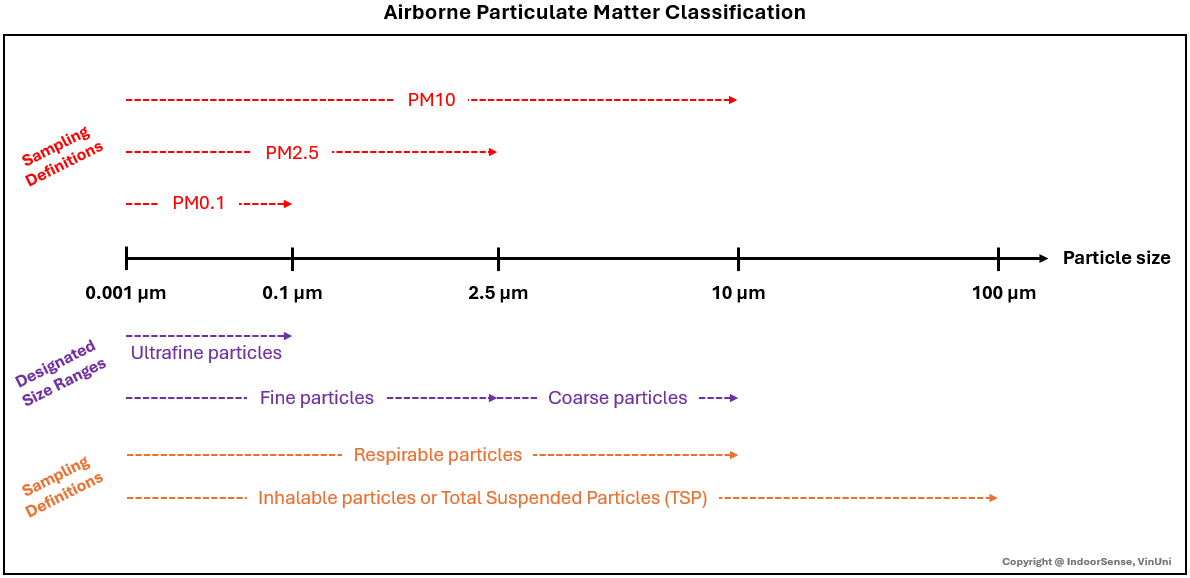Types of airborne particles and their action mechanisms on human health
Author: Nhan Dinh Ngo - VinUniversity
Types of airborne particles
Airborne particles including solids, liquids (droplets), and mixtures of them are present throughout our ambient environment, often denoted by terms like PM2.5 or fine dust. But what lies behind these designations? Generally, these names denote various airborne particle catalogs classified by size. It is essential to understand that these particles come in diverse sizes and shapes (as Figure 1). For instance, liquid particles are nearly always spherical while solid particles usually have complex shapes. Thus, the classification relies not on physical dimensions like diameter, radius, or height, but rather on an equivalent diameter, termed “aerodynamic diameter”. Figure 2 visualizes the size range of airborne particles. In general:
- Total Suspended Particles (TSP), also known as Inhalable Particles, refers to all particles found in the ambient atmosphere. This type of particle is typically 100 micrometers (µm) or less in size. Particles exceeding this threshold fall to the ground quickly by gravitation, thus, they are considered not inhalable.
- In the meanwhile, respirable particles constitute a subset of inhalable particles comprising any smaller particles, typically less than 10 µm in size. While inhalable particles are large enough to be trapped in the nose, throat, and upper respiratory tract, respirable particles are small enough to reach the deepest parts of the lungs bypassing the body’s natural defenses.
- Within the range of respirable particles, various fractions exist, including PM0.1, PM2.5, and PM10. The suffix index denotes the largest particle size. For example, PM2.5 covers all respirable particles that are 2.5 (µm) or less in size. It’s important to note that PM10 corresponds to respirable particles, as depicted in Figure 2. Furthermore, the airborne particles can be categorized into ultrafine, fine, and coarse particles based on Designated Size Ranges as illustrated in Figure 2. There is a common misconception that the coarse particles correspond to PM10. Unfortunately, it is not actually! Ultrafine and fine particles will correspond to PM0.1 and PM2.5, respectively, while coarse particles constitute only a subset of PM10.


In conclusion, the airborne particle classification relies on the concept of equivalent diameter, termed “aerodynamic diameter”, rather than physical dimensions. Total Suspended Particles (TSP), or Inhalable Particles by another name, encompass all particles found in the air. Respirable particles, a subset of inhalable particles, comprise various fractions like PM0.1, PM2.5, and PM10. Additionally, airborne particles can be categorized into ultrafine, fine, and coarse particles with ultrafine and fine particles corresponding to PM0.1 and PM2.5, respectively, while coarse particles constitute only a subset of PM10.
How do airborne particles affect human health?
Size and composition both significantly play a role in the mechanisms of action of airborne particles on human health. The size directly relates to the particle’s traveling distance and deposition spots while the composition determines their toxicity. More specifically:
- Size of airborne particles: generally, the smaller the particles, the deeper penetration into the human respiratory tract. For instance, only PM2.5 and smaller will penetrate deep into the lungs and some may even get into the bloodstream, while PM10 tends to lodge in the trachea (upper throat) or in the bronchi. Since penetrating the human body, they are carrying various chemical and biological substances, which are present on their surface, into the body therefore causing toxic effects as below explanations.
- Composition of airborne particles: airborne particles can act as carriers of compound particles with chemical and biological origins (Guo et al., 2018). For example, transition metals present in particles, especially iron, increase the production of reactive oxygen species (ROS). As the release of ROS can result in cellular and tissue damage, it can thus initiate or exacerbate inflammation. Another example of the health effects of biological source-laden airborne particles is that the endotoxins, a kind of toxic release from bacteria, can adhere to the surface of particles and accompany them into the lungs, thereby resulting in more pronounced immunological reactions than the particles themselves.
In summary, the main mechanism of action of airborne particles on human health, specifically on the respiratory system, lies in the chemical and biological composition carried by particles, thereby inducing adverse effects such as oxidative stress and inflammation.
References
Guo, Z., Wang, Z., Qian, L., Zhao, Z., Zhang, C., Fu, Y., Li, J., Zhang, C., Lu, B., & Qian, J. (2018). Biological and chemical compositions of atmospheric particulate matter during hazardous haze days in Beijing. Environmental Science and Pollution Research International, 25(34), 34540. Pöschl, U. (2005). Atmospheric aerosols: composition, transformation, climate and health effects. Angewandte Chemie (International Ed. in English), 44(46), 7520–7540.